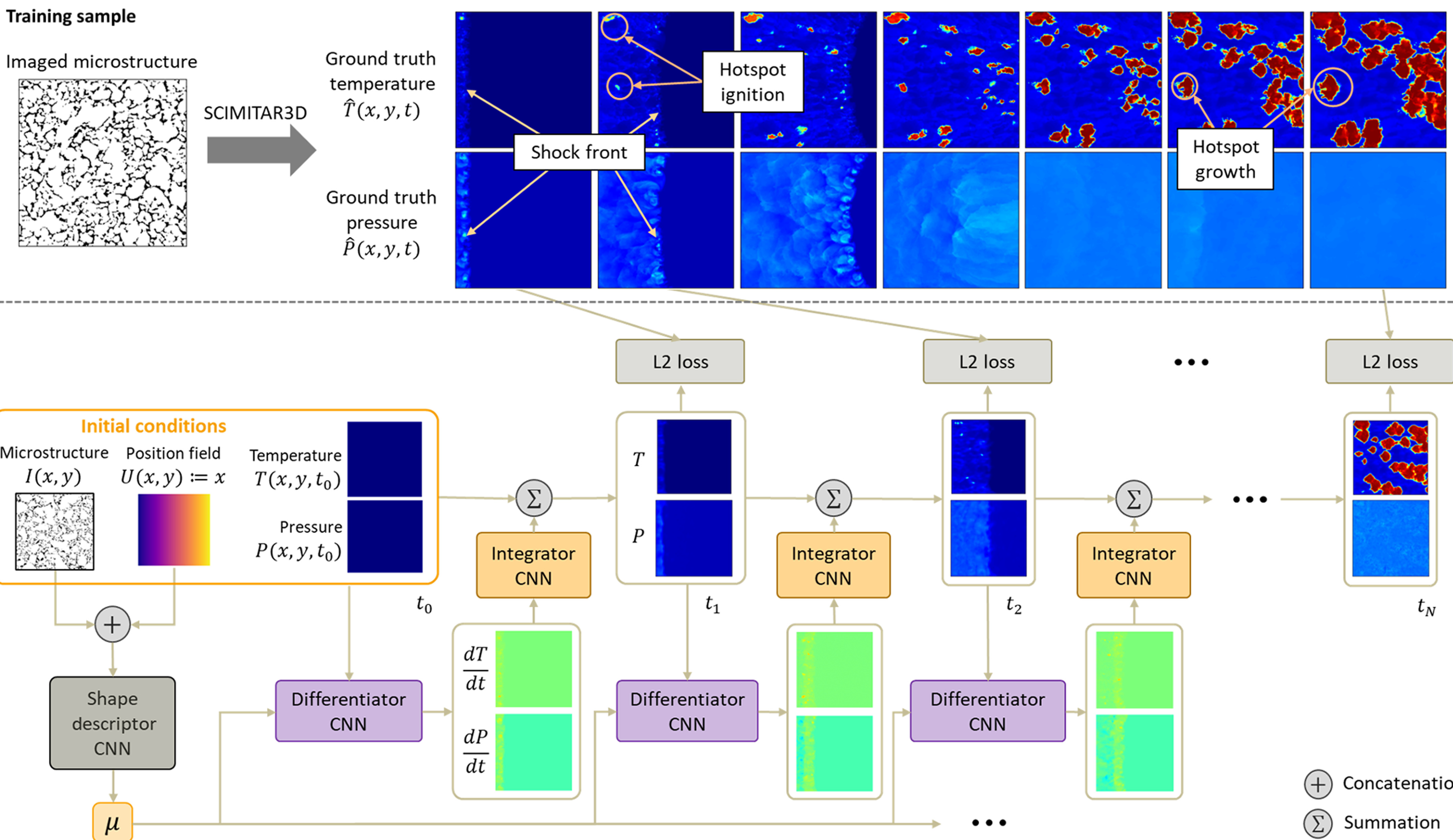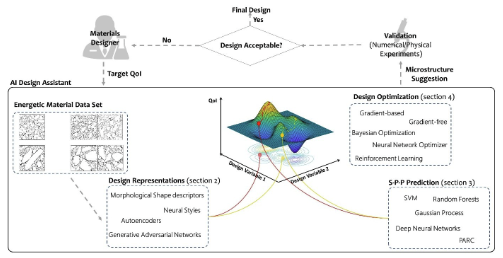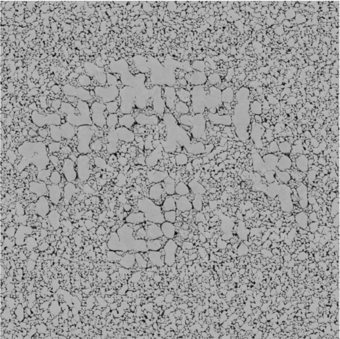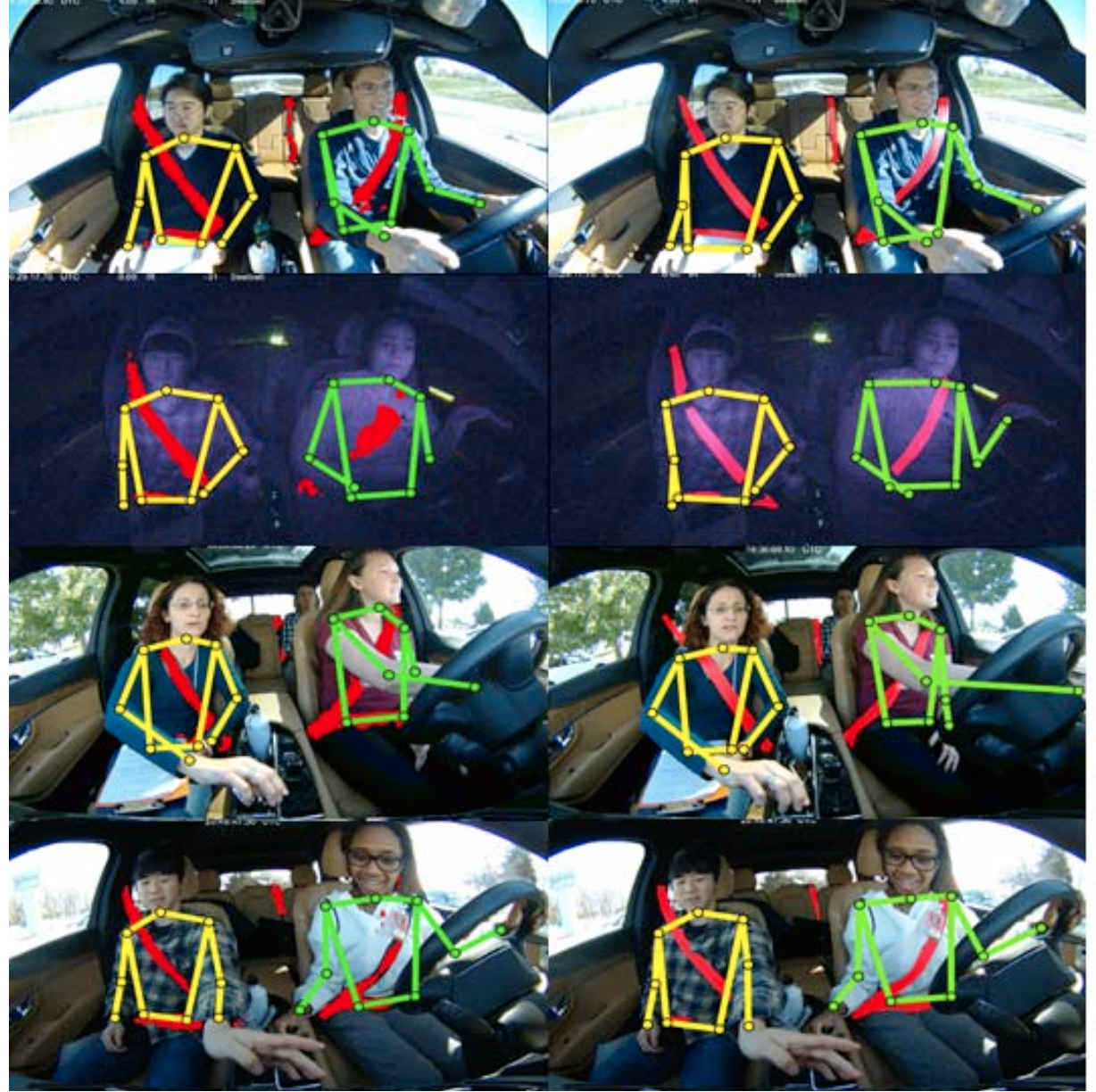publications
publications by categories in reversed chronological order.
2023
-
 A Physics-Aware Deep Learning Model for Energy Localization in Multiscale Shock-To-Detonation Simulations of Heterogeneous Energetic MaterialsPhong C H Nguyen , Yen-Thi Nguyen , Pradeep K Seshadri , and 3 more authorsPropellants, explosives, pyrotechnics, 2023
A Physics-Aware Deep Learning Model for Energy Localization in Multiscale Shock-To-Detonation Simulations of Heterogeneous Energetic MaterialsPhong C H Nguyen , Yen-Thi Nguyen , Pradeep K Seshadri , and 3 more authorsPropellants, explosives, pyrotechnics, 2023Predictive simulations of the shock-to-detonation transition (SDT) in heterogeneous energetic materials (EM) are vital to the design and control of their energy release and sensitivity. Due to the complexity of the thermo-mechanics of EM during the SDT, both macro-scale response and sub-grid mesoscale energy localization must be captured accurately. This work proposes an efficient and accurate multiscale framework for SDT simulations of EM. We introduce a new approach for SDT simulation by using deep learning to model the mesoscale energy localization of shock-initiated EM microstructures. The proposed multiscale modeling framework is divided into two stages. First, a physics-aware recurrent convolutional neural network (PARC) is used to model the mesoscale energy localization of shock-initiated heterogeneous EM microstructures. PARC is trained using direct numerical simulations (DNS) of hotspot ignition and growth within microstructures of pressed HMX material subjected to different input shock strengths. After training, PARC is employed to supply hotspot ignition and growth rates for macroscale SDT simulations. We show that PARC can play the role of a surrogate model in a multiscale simulation framework, while drastically reducing the computation cost and providing improved representations of the sub-grid physics. The proposed multiscale modeling approach will provide a new tool for material scientists in designing high-performance and safer energetic materials.
@article{nguyen2023physics, title = {A Physics-Aware Deep Learning Model for Energy Localization in Multiscale Shock-To-Detonation Simulations of Heterogeneous Energetic Materials}, author = {Nguyen, Phong C H and Nguyen, Yen-Thi and Seshadri, Pradeep K and Choi, Joseph B and Udaykumar, HS and Baek, Stephen}, journal = {Propellants, explosives, pyrotechnics}, volume = {48}, number = {4}, pages = {e202200268}, year = {2023}, publisher = {Wiley Online Library}, } - Challenges and opportunities for machine learning in multiscale computational modelingPhong CH Nguyen , Joseph B Choi , HS Udaykumar , and 1 more authorJournal of Computing and Information Science in Engineering, 2023
Many mechanical engineering applications call for multiscale computational modeling and simulation. However, solving for complex multiscale systems remains computationally onerous due to the high dimensionality of the solution space. Recently, machine learning (ML) has emerged as a promising solution that can either serve as a surrogate for, accelerate or augment traditional numerical methods. Pioneering work has demonstrated that ML provides solutions to governing systems of equations with comparable accuracy to those obtained using direct numerical methods, but with significantly faster computational speed. These high-speed, high-fidelity estimations can facilitate the solving of complex multiscale systems by providing a better initial solution to traditional solvers. This paper provides a perspective on the opportunities and challenges of using ML for complex multiscale modeling and simulation. We first outline the current state-of-the-art ML approaches for simulating multiscale systems and highlight some of the landmark developments. Next, we discuss current challenges for ML in multiscale computational modeling, such as the data and discretization dependence, interpretability, and data sharing and collaborative platform development. Finally, we suggest several potential research directions for the future.
@article{nguyen2023challenges, title = {Challenges and opportunities for machine learning in multiscale computational modeling}, author = {Nguyen, Phong CH and Choi, Joseph B and Udaykumar, HS and Baek, Stephen}, journal = {Journal of Computing and Information Science in Engineering}, volume = {23}, number = {6}, pages = {060808}, year = {2023}, publisher = {American Society of Mechanical Engineers}, } -
 PARC: Physics-aware recurrent convolutional neural networks to assimilate meso scale reactive mechanics of energetic materialsPhong CH Nguyen , Yen-Thi Nguyen , Joseph B Choi , and 3 more authorsScience advances, 2023
PARC: Physics-aware recurrent convolutional neural networks to assimilate meso scale reactive mechanics of energetic materialsPhong CH Nguyen , Yen-Thi Nguyen , Joseph B Choi , and 3 more authorsScience advances, 2023The thermo-mechanical response of shock-initiated energetic materials (EMs) is highly influenced by their microstructures, presenting an opportunity to engineer EM microstructures in a “materials-by-design” framework. However, the current design practice is limited, as a large ensemble of simulations is required to construct the complex EM structure-property-performance linkages. We present the physics-aware recurrent convolutional (PARC) neural network, a deep learning algorithm capable of learning the mesoscale thermo-mechanics of EM from a modest number of high-resolution direct numerical simulations (DNS). Validation results demonstrated that PARC could predict the themo-mechanical response of shocked EMs with comparable accuracy to DNS but with notably less computation time. The physics-awareness of PARC enhances its modeling capabilities and generalizability, especially when challenged in unseen prediction scenarios. We also demonstrate that visualizing the artificial neurons at PARC can shed light on important aspects of EM thermos-mechanics and provide an additional lens for conceptualizing EM.
@article{nguyen2023parc, title = {PARC: Physics-aware recurrent convolutional neural networks to assimilate meso scale reactive mechanics of energetic materials}, author = {Nguyen, Phong CH and Nguyen, Yen-Thi and Choi, Joseph B and Seshadri, Pradeep K and Udaykumar, HS and Baek, Stephen S}, journal = {Science advances}, volume = {9}, number = {17}, pages = {eadd6868}, year = {2023}, publisher = {American Association for the Advancement of Science}, } -
 Artificial intelligence approaches for energetic materials by design: state of the art, challenges, and future directionsJoseph B Choi , Phong CH Nguyen , Oishik Sen , and 2 more authorsPropellants, explosives, pyrotechnics, 2023
Artificial intelligence approaches for energetic materials by design: state of the art, challenges, and future directionsJoseph B Choi , Phong CH Nguyen , Oishik Sen , and 2 more authorsPropellants, explosives, pyrotechnics, 2023Artificial intelligence (AI) is rapidly emerging as a enabling tool for solving complex materials design problems. This paper aims to review recent advances in AI-driven materials-by-design and their applications to energetic materials (EM). Trained with data from numerical simulations and/or physical experiments, AI models can assimilate trends and patterns within the design parameter space, identify optimal material designs (micro-morphologies, combinations of materials in composites, etc.), and point to designs with superior/targeted property and performance metrics. We review approaches focusing on such capabilities with respect to the three main stages of materials-by-design, namely representation learning of microstructure morphology (i. e., shape descriptors), structure-property-performance (S−P−P) linkage estimation, and optimization/design exploration. We leave out “process” as much work remains to be done to establish the connectivity between process and structure. We provide a perspective view of these methods in terms of their potential, practicality, and efficacy towards the realization of materials-by-design. Specifically, methods in the literature are evaluated in terms of their capacity to learn from a small/limited number of data, computational complexity, generalizability/scalability to other material species and operating conditions, interpretability of the model predictions, and the burden of supervision/data annotation. Finally, we suggest a few promising future research directions for EM materials-by-design, such as meta-learning, active learning, Bayesian learning, and semi-/weakly-supervised learning, to bridge the gap between machine learning research and EM research.
@article{choi2023artificial, title = {Artificial intelligence approaches for energetic materials by design: state of the art, challenges, and future directions}, author = {Choi, Joseph B and Nguyen, Phong CH and Sen, Oishik and Udaykumar, HS and Baek, Stephen}, journal = {Propellants, explosives, pyrotechnics}, volume = {48}, number = {4}, pages = {e202200276}, year = {2023}, publisher = {Wiley Online Library}, }
2022
-
 Federated learning enables big data for rare cancer boundary detectionSarthak Pati , Ujjwal Baid , Brandon Edwards , and 8 more authorsNature communications, 2022
Federated learning enables big data for rare cancer boundary detectionSarthak Pati , Ujjwal Baid , Brandon Edwards , and 8 more authorsNature communications, 2022Although machine learning (ML) has shown promise in numerous domains, there are concerns about generalizability to out-of-sample data. This is currently addressed by centrally sharing ample, and importantly diverse, data from multiple sites. However, such centralization is challenging to scale (or even not feasible) due to various limitations. Federated ML (FL) provides an alternative to train accurate and generalizable ML models, by only sharing numerical model updates. Here we present findings from the largest FL study to-date, involving data from 71 healthcare institutions across 6 continents, to generate an automatic tumor boundary detector for the rare disease of glioblastoma, utilizing the largest dataset of such patients ever used in the literature (25,256 MRI scans from 6,314 patients). We demonstrate a 33 percent improvement over a publicly trained model to delineate the surgically targetable tumor, and 23 percent improvement over the tumor’s entire extent. We anticipate our study to: 1) enable more studies in healthcare informed by large and diverse data, ensuring meaningful results for rare diseases and underrepresented populations, 2) facilitate further quantitative analyses for glioblastoma via performance optimization of our consensus model for eventual public release, and 3) demonstrate the effectiveness of FL at such scale and task complexity as a paradigm shift for multi-site collaborations, alleviating the need for data sharing.
@article{pati2022federated, title = {Federated learning enables big data for rare cancer boundary detection}, author = {Pati, Sarthak and Baid, Ujjwal and Edwards, Brandon and Sheller, Micah and Wang, Shih-Han and Reina, G Anthony and Foley, Patrick and Gruzdev, Alexey and Karkada, Deepthi and Davatzikos, Christos and others}, journal = {Nature communications}, volume = {13}, number = {1}, pages = {7346}, year = {2022}, publisher = {Nature Publishing Group UK London}, } - Establishing the structure-property-performance linkage of pressed energetic materials using physics-aware recurrent convolutional neural networks (PARC)Phong Nguyen , Josepoh B Choi , Yen-Thi Nguyen , and 2 more authorsAPS Shock Compression of Condensed Matter Meeting Abstracts, 2022
Establishing the structure-property-performance (SPP) linkages is a vital task for the design of energetic materials (EM). However, the current approaches for establishing SPP linkages are limited by time-consuming and costly physical and numerical experiments, rendering practical challenges in exploring the vast design space of EM microstructures. In this work, we propose a novel deep learning method called physics-aware recurrent convolutional neural network (PARC), which can assimilate the thermo-mechanics of hotspot ignition and growth in shocked heterogeneous EM microstructures. PARC is designed to predict the time evolution of temperature and pressure fields by modeling and solving the governing differential equations using convolutional neural networks (CNN). In contrast to other machine learning approaches, the unique recurrent convolutional architecture modeling the governing differential equations makes PARC highly interpretable and “physics-aware.” The validation results show that PARC can predict the thermomechanical behavior of shock-induced EM microstructures with high accuracy (within 5 percent error) compared to direct numerical simulation (DNS) results, despite a dramatic reduction of computation time (up to 3000 times). Furthermore, we also show that the interpretable architecture of PARC provides additional lenses for the study of SPP linkages by shedding light on identifying the morphological characteristic of microstructures that lead to energy localization and initiation. The impact of the current work is a novel capacity to estimate SPP linkages in a significantly quicker turnaround, enabling the design of EM microstructures with engineered properties.
@article{nguyen2022establishing, title = {Establishing the structure-property-performance linkage of pressed energetic materials using physics-aware recurrent convolutional neural networks (PARC)}, author = {Nguyen, Phong and Choi, Josepoh B and Nguyen, Yen-Thi and Udaykumar, H. S. and Baek, Stephen}, journal = {APS Shock Compression of Condensed Matter Meeting Abstracts}, year = {2022}, pages = {P03. 002}, } - A Novel AI-Assisted Framework for Microstructural Design of Shocked MaterialsJoseph B Choi , Phong Nguyen , Yen-Thi Nguyen , and 2 more authorsAPS Shock Compression of Condensed Matter Meeting Abstracts, 2022
Advanced manufacturing technologies have enabled the fabrication of complex metamaterial microstructures. However, their complex structure-property-performance (SPP) relationships require costly and laborious experiments, making it impractical to explore the large and complex design space. In this study, we propose a new design framework to discover optimal microstructure designs using deep neural networks. The proposed framework is demonstrated on a problem of optimizing the shock sensitivity of pressed cyclotetramethylene-tetranitramine (HMX). In this framework, we learn micromorphology descriptors using generative adversarial networks (GAN) to depict the latent space and accelerate the estimation of material properties using Bayesian physics-aware recurrent convolutional neural networks (B-PARC). In conjunction with B-PARC, the differential evolution approach is employed to practically navigate the design space. As intermediate results, the optimal microstructure candidates produced by B-PARC and differential evolution are validated against direct numerical simulations, then the B-PARC is recalibrated with updated data before proceeding to the next iteration. The new framework achieved a significant design improvement compared to the best performing structure in the dataset.
@article{choi2022novel, title = {A Novel AI-Assisted Framework for Microstructural Design of Shocked Materials}, author = {Choi, Joseph B and Nguyen, Phong and and Nguyen, Yen-Thi and Udaykumar, H. S. and Baek, Stephen}, journal = {APS Shock Compression of Condensed Matter Meeting Abstracts}, year = {2022}, pages = {U03.004}, }
2020
-
 Deep learning for synthetic microstructure generation in a materials-by-design framework for heterogeneous energetic materialsSehyun Chun , Sidhartha Roy , Yen Thi Nguyen , and 3 more authorsScientific reports, 2020
Deep learning for synthetic microstructure generation in a materials-by-design framework for heterogeneous energetic materialsSehyun Chun , Sidhartha Roy , Yen Thi Nguyen , and 3 more authorsScientific reports, 2020The sensitivity of heterogeneous energetic (HE) materials (propellants, explosives, and pyrotechnics) is critically dependent on their microstructure. Initiation of chemical reactions occurs at hot spots due to energy localization at sites of porosities and other defects. Emerging multi-scale predictive models of HE response to loads account for the physics at the meso-scale, i.e. at the scale of statistically representative clusters of particles and other features in the microstructure. Meso-scale physics is infused in machine-learned closure models informed by resolved meso-scale simulations. Since microstructures are stochastic, ensembles of meso-scale simulations are required to quantify hot spot ignition and growth and to develop models for microstructure-dependent energy deposition rates. We propose utilizing generative adversarial networks (GAN) to spawn ensembles of synthetic heterogeneous energetic material microstructures. The method generates qualitatively and quantitatively realistic microstructures by learning from images of HE microstructures. We show that the proposed GAN method also permits the generation of new morphologies, where the porosity distribution can be controlled and spatially manipulated. Such control paves the way for the design of novel microstructures to engineer HE materials for targeted performance in a materials-by-design framework.
@article{chun2020deep, title = {Deep learning for synthetic microstructure generation in a materials-by-design framework for heterogeneous energetic materials}, author = {Chun, Sehyun and Roy, Sidhartha and Nguyen, Yen Thi and Choi, Joseph B and Udaykumar, Holavanahalli S and Baek, Stephen S}, journal = {Scientific reports}, volume = {10}, number = {1}, pages = {13307}, year = {2020}, publisher = {Nature Publishing Group UK London}, }
2019
-
 NADS-Net: A nimble architecture for driver and seat belt detection via convolutional neural networksSehyun Chun , Nima Hamidi Ghalehjegh , Joseph Choi, and 4 more authorsIn Proceedings of the IEEE/CVF International Conference on Computer Vision Workshops , 2019
NADS-Net: A nimble architecture for driver and seat belt detection via convolutional neural networksSehyun Chun , Nima Hamidi Ghalehjegh , Joseph Choi, and 4 more authorsIn Proceedings of the IEEE/CVF International Conference on Computer Vision Workshops , 2019A new convolutional neural network (CNN) architecture for 2D driver/passenger pose estimation and seat belt detection is proposed in this paper. The new architecture is more nimble and thus more suitable for in-vehicle monitoring tasks compared to other generic pose estimation algorithms. The new architecture, named NADS-Net, utilizes the feature pyramid network (FPN) backbone with multiple detection heads to achieve the optimal performance for driver/passenger state detection tasks. The new architecture is validated on a new data set containing video clips of 100 drivers in 50 driving sessions that are collected for this study. The detection performance is analyzed under different demographic, appearance, and illumination conditions. The results presented in this paper may provide meaningful insights for the autonomous driving research community and automotive industry for future algorithm development and data collection.
@inproceedings{chun2019nads, title = {NADS-Net: A nimble architecture for driver and seat belt detection via convolutional neural networks}, author = {Chun, Sehyun and Hamidi Ghalehjegh, Nima and Choi, Joseph and Schwarz, Chris and Gaspar, John and McGehee, Daniel and Baek, Stephen}, booktitle = {Proceedings of the IEEE/CVF International Conference on Computer Vision Workshops}, pages = {0--0}, year = {2019}, }